A Walking Tour of “Old” Panajachel
Panajachel is firstly a walking city. If you drive in it, you soon tire of the paucity of two-way streets. And every rocky contour of those streets registers on the pant-seat of every chicken-bus rider. Tuktuks look fun, until you actually ride in one. And much of Pana is not overly bike-friendly. So, unless pogo sticks catch on, feet remain the preferred vehicle.
Pana, unlike La Antigua, is no predictable grid. There are countless blind corners and weird angles, all inviting, particularly in Uptown, or Old Pana, the town’s oldest quarter (downtown, or “El Centro” is considered the spot where Calle Santander starts). Uptown is the most walkable part of Pana, and its corners beckon to be rounded and savored with the slowness that only pedestrians can succor.
Uptown is eclectic, given its compactness. I could argue that visitors to Pana have not really visited unless they traipse through Uptown. Everyone strolls Santander and the waterfront, but Uptown is Panajachel at its most authentic. You meet few or no peddlers in Old Pana, and it is an arresting counterpoint to the “touristy” face of that other Pana.
Start at the intersection of Calle Principal and Palopó Road. There sits (1) El Ancla, Pana’s original general store, where they still sell a little of everything that is not perishable, from stationery to fishing line. It is Pana’s oldest retailer in continuous operation, a success owed to the Mazarriegos family’s policy of standing behind everything they sell since 1956.
The next place meriting a stop once occasioned a bizarre exchange for me with a Polish couple. They looked lost, so I offered directions. It seemed that they were asking me if I knew the “Maya Canuck.” Well, I did know Rick McArthur, a Canadian who speaks Maya Kakchikel in his work with Wycliffe translators, and who had been called this. But when I offered to lead them to Rick, they were confounded.
Eventually it dawn-ed that their destination was (2) the Maya Kanek, Panajachel’s oldest hotel, which predates the 1961 electrification of the city by decades. Its lobby, featuring intriguing codex-like murals, is unchanged from the days when it was Uptown’s only comfortable lodging. The “coffee table” is a shellacked slice of a tree trunk. Don Antonio, the affable proprietor, can answer questions about Panajachel history.
A little farther up the street, you find Panajachel’s newest and strangest landmark (3).
“Torchito,” as the statue atop the pedestal is known, was erected in 2007 to commem-orate 50 years of the annual footrace that originally linked Pana with nearby San Andrés Semetabaj; today, the torch is borne all the way to Guatemala City. One of Torchito’s feet is bare, honoring those of the original runners who ran the course on their unshod feet.
Just behind Torchito is (4) Panajachel’s city park. Behind the small, shaded promenades and the sculptures of T-rex and President Barrios, the municipal “palace” perches on a stony platform. There is nothing palatial about the building, but the platform boasts (5) a relief mural carved in 1980 by Jordán Alegría, showing an allegorization of the conquest. On the right, a resplendent, feathered Tecún Umán resists a charge from a mounted Pedro de Alvarado. The latter’s forces, on the left, are a mix of Spaniards and Alvarado’s Tlaxcaltecan (Mexican) allies. It may be my imagination, but the figures on the right seem, by design, of nobler countenance.
Continue up the street to (6) Pana’s new mercado.
The old mercado, a smelly warren of ramshackle stalls, would never have been a stop on any walking tour. Trash and vermin were never far from the wares on sale. But today’s mercado enjoys a planned layout that is a paragon of space utility, airiness, aesthetics and sanitation. The expansive rain shield protects from the elements while allowing full ventilation, as well as full exploitation of natural light. Despite this manicured presentation of a highlands marketplace, no authenticity was sacrificed. You never forget that you are in Guatemala, since all the usual ingredients are present: produce stalls, dry-goods sellers, alcoves of meatcutters, humble diners, clothiers and a local for reed baskets and mats. Your tour should include some roaming here.
A side street leads to (7) the new municipal library, the finest in Sololá Department, and Uptown’s true palace. The library, with its arched windows and wrought-iron grating, replaces an older one that burned down in 2000. It owes its existence to indefatigable American author Ann Cameron and her husband Bill, and doubles as the town museum. Labeled exhibits of historical pictures and textiles adorn the walls and pylons. The most poignant exhibit is a page from one of the 8,000 books destroyed in the fire.
After you exit the library, cross the street toward the Catholic church. Within the elegant gate you can see finely sculpted floral mounds and collared trees. Go right, following the sidewalk to the (8) church plaza, Uptown’s only open space. Pana’s City Hall departs from the norm by sitting behind the church, rather than facing it over a plaza. Open-air and official ceremonies nonetheless take place on this spot: Deer Dances, Catholic processions, and the annual feria all culminate here.
Across the street stands the medieval-looking (9) belfry, believed to be Pana’s oldest edifice. The bell inside, massively cracked, is seldom rung.
From the plaza, enter the (10) church dedicated to St. Francis of Assisi, Pana’s patron. The thick granite walls of the current church, dating from the 1800s, soften the bustle of Panajachel, making the church a favorite interfaith meditation spot.
From the plaza, go south again into Pana’s oldest commercial area, which before the tourist boom of the 80s was home to coffee and grain brokers. Even today the aroma of fresh coffee is piped into this quarter of barbers and tailors by the Roberts family of South Africa, to allure walkers to their (11) Crossroads Café, where premium coffees can be sampled and bought in bulk.
Turn left at the next corner to reach the clinic and (12) gallery of pediatrician Gerardo Barreno, a self-described “Mayaphile.” Dr. Barreno, who charges as little as Q10 for consultations, provides scultptors, painters and artisans with a free showcase that has launched careers. It may be the perfect spot to buy a memento of your walk through Old Panajachel, or, if nothing else, to see Mona Lisa with Maya features.
photos by Shaila Reddy
- Walking Tour of “Old” Panajachel
- (1) El Ancla
- (2) Maya Kanek
- (3) Torchito
- (4) City Park
- (5) Relief Mural
- (6) New Market
- (7) Municipal Library
- (8) Church Plaza
- (9) Belfry
- (11) Café
- (12) Gallery
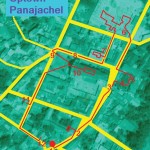
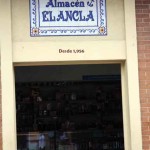
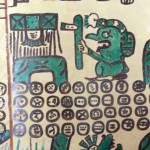
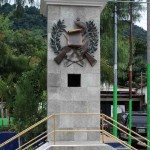
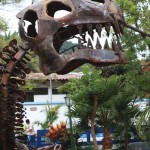
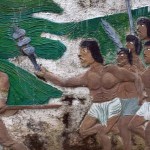
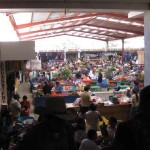
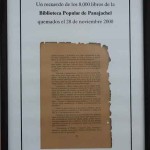
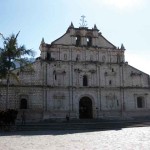
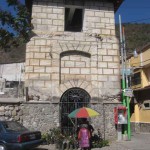
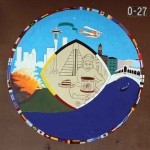
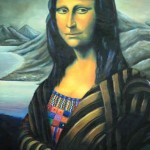
Great article, as always, Mr. Coop!